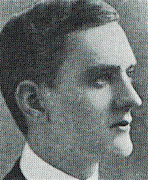
Owen Percy Parsons [also known as Owen P. Parsons, and as O. P. Parsons] was born in Birmingham, England, on 22 July 1874*. Through his mother's side of the family, he was related to the painter David Cox (1783-1859). He was articled to Sam Owen of Owen & Ward in Birmingham and from 1893 to 1895 to John George Bland (1820-1898) in Birmingham
In 1895 Parsons established his own independent practice at Victoria Chambers, Martineau Street, Birmingham, and, following Bland's death in 1898, took over his practice at 14 Temple Street, Birmingham where he remained until 1930. He also had an office at 40 High Street, Erdington from 1913 to 1919. He relocated the practice from Temple Street to Newton Chambers, 43 Cannon Street, Birmingham where he remained until 1943 when the office was destroyed in an air raid.
Parson's practice mainly designed dwelling houses, predominantly in the Arts and Crafts style. Most of his works works were in the Birmingham area.
A photograph and a plan of the grounds of 'Hindecliffe', Four Oaks , and photographs of the entrance hall and dining room at the Rectory Farm, Streatle, designed by Parsons are illustrated in 'The Studio Yearbook of Decorative Art' 1907 (pp.38, 64), a drawing and ground-floor plan of a house at Moseley designed by Parsons is illustrated in 'The Studio Yearbook of Decorative Art' 1910 (p.66), a photograph and a ground-floor plan of 'Kilmuir', Moseley, designed by Parsons is illustrated in 'the Studio Yearbook of Decorative Art' 1911 (p.64), and a watercolour drawing of a house at Moseley designed by Parsons is illustrated in 'The Studio Yearbook of Decorative Art' 1916 (p.41).
Parsons was elected a Licentiate of the Royal Institute of British Architects (LRIBA) in 1911. He exhibited at the Royal Society of Arts in Birmingham and the Royal Academy in London between 1904 and 1933. His address was given as 14 Greenhill Road, Sutton Coldfield, Warwickshire in 1939. He died at his home, Holmwood, Green Hill Road, Wylde Green, Birmingham on 15 February 1944.
_____
* Parsons' year of birth is sometimes given as 1872 and 1876, however, this is date of his birth given in the 1939 England and Wales Register
Architectural projects by Parsons included The Lawns, 16 Bracebridge Road, Four Oaks (1899); 19 and 21 Salisbury Road, Moseley (1901); 47-65 Selly Park Road, Selly Park, Birmingham (1905); 130 Oxford Road, Moseley, Birmingham (c.1907); Kilmuir Amesbury Road, Moseley (1909); Kingsthorpe, 40 Wake Green Road, Moseley, Birmingham (1910); Holmwood, 14 Greenhill Road, Sutton Coldfield (1912); Walmley Golf Club House (1919); Tintagel, Greenhill Road, Sutton Coldfield (1919); Donegal, 3 Beech Hill Road, Sutton Coldfield (1920); Talgarth, 2 Greenhill Road, Sutton Coldfield (1923); Greenhill Cottage, 10 Greenhill Road, Sutton Coldfield (1924); Culross House, 5 Luttrell Road, Sutton Coldfield (1928); Red Mullion, 8 Bracebridge Road, Four Oaks (1929).
_____
For a selected list of architectural works by Owen P. Parsons see also Rathbone, Niky and Bassindale, John. ‘Owen Parsons’ pp. 563-565 [Bibliography below]
Directory of British Architects 1834-1914. Compiled by Antonia Brodie, et al. Volume 2: L-Z. London; New York: British Architectural Library, Royal Institute of British Architects/Continuum, 2001
'Obituary'. The Builder vol. 166, 3 March 1944 p. 172
Rathbone, Niky and Bassindale, John. ‘Owen Parsons’ in Birmingham's Victorian and Edwardian Architects, edited by Phillada Ballard. Wetherby: Oblong Creative Ltd. for the Birmingham and West Midlands Group of the Victorian Society, 2009 pp. 555–566.